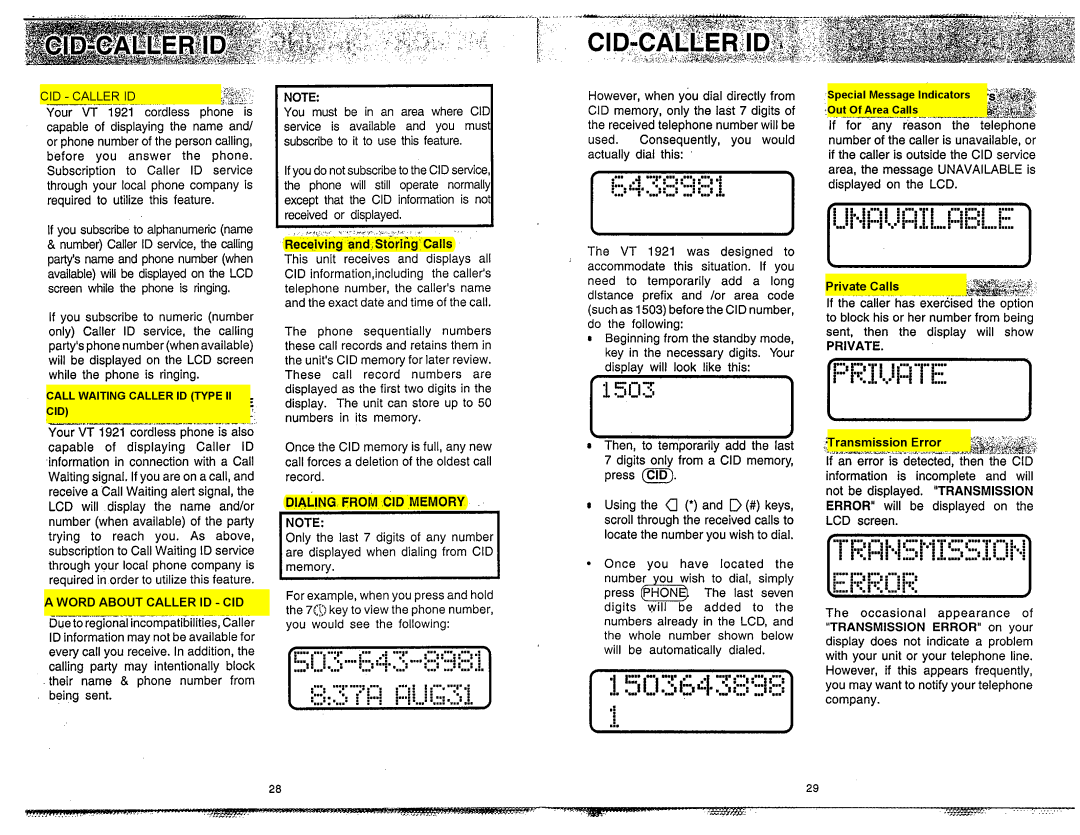
CID - CALLER ID
Your VT 1921 cordless phone is capable of displaying the name and/ or phone number of the person calling, before you answer the phone. Subscription to Caller ID service through your local phone company is required to utilize this feature.
If you subscribe to alphanumeric (name
&number) Caller ID service, the calling party'sname and phone number (when available) will be displayed on the LCD screen while the phone is ringing.
If you subscribe to numeric (number only) Caller ID service, the calling party's phonenumber(whenavailable) will be displayed on the LCD screen while the phone is ringing.
CALL WAITING CALLER ID (TYPE II CID)
Your VT 1921 cordless phone is also capable of displaying Caller ID
NOTE: |
|
You must be in an area where CID | |
service is available and you mus | |
subscribe to it to use this feature. | I |
If you do not subscribe to the CID service,4 the phone will still operate normally except that the CID information is no received or displayed.
Y ". , , . ,
Receiving and,storirig Calls
This unit receives and displays all CID information,including the caller's telephone number, the caller'sname and the exact date and time of the call.
The phone sequentially numbers these call records and retains them in the unit'sCID memory for later review. These call record numbers are displayed as the first two digits in the display. The unit can store up to 50 numbers in its memory.
Once the CID memory is full, any new
|
|
| Special Message Indicators |
| |||
|
|
| Out Of Area Calls |
| |||
the received telephone number will be |
| If for 'any reason the telephone | |||||
used. | Consequently, you would |
| number of the caller is unavailable, or | ||||
actually dial this: ' |
| if the caller is outside the CID service | |||||
.... | .I.............# ::...,, |
| area, the message UNAVAILABLE is | ||||
|
|
| |||||
I"':::i |
| displayed on the LCD. | |||||
... | : |
|
|
|
|
| |
The VT 1921 was designed to |
|
|
|
|
| ||
' accommodate this situation. If you |
|
|
|
|
| ||
need to temporarily add a long | Private Calls |
|
|
| |||
dlstance prefix and /or area code | If the caller has exercised the option | ||||||
(suchas 1503)beforethe CID number, | |||||||
to block his or her number from being | |||||||
do the | following: | ||||||
sent, then the display will show | |||||||
Beginning from the standby mode, | |||||||
PRIVATE. | |||||||
key in the necessary digits. Your | |||||||
|
|
|
|
| |||
display will look like this: |
|
|
|
|
| ||
r | '. |
|
|
|
|
| |
|
|
|
|
| |||
|
| ||||||
Then, to temporarily add the last |
| Transmission Error |
| ||||
information in connection with a Call Waiting signal. If you are on a call, and receive a Call Waiting alert signal, the LCD will display the name and/or number (when available) of the party trying to reach you. As above, subscription to Call Waiting ID service through your local phone company is required in order to utilize this feature.
A WORD ABOUT CALLER ID - CID
ID informitionmay n i t be available for every call you receive. In addition, the calling party may intentionally block their name & phone number from being sent.
call forces a deletion of the oldest call record.
DIALING FROM CID MEMORY
NOTE:
Only the last 7 digits of any number are displayed when dialing from CID
For example, when you press and hold the 7CQkey to view the phone number, you would see the following:
.....,...'*:i'j...] | i...ii | ii . . |
| ... i |
I....., | .....: | 1 .... | ,...I..: | |
m | : : | : | .:. | |
7 digits only from a CID memory,
press (CID).
Using the a (*) and D(#) keys, scroll through the received calls to locate the number you wish to dial.
Once you have located the number ou wish to dial, simply press @ h l l The last seven digits will be added to the numbers already in the LCD, and the whole number shown below will be automatically dialed.
If an error is detected, then the CID information is incomplete and will not be displayed. "TRANSMISSION ERROR" will be displayed on the LCD screen.
The occasional appearance of "TRANSMISSION ERROR" on your display does not indicate a problem with your unit or your telephone line. However, if this appears frequently, you may want to notify your telephone company.
